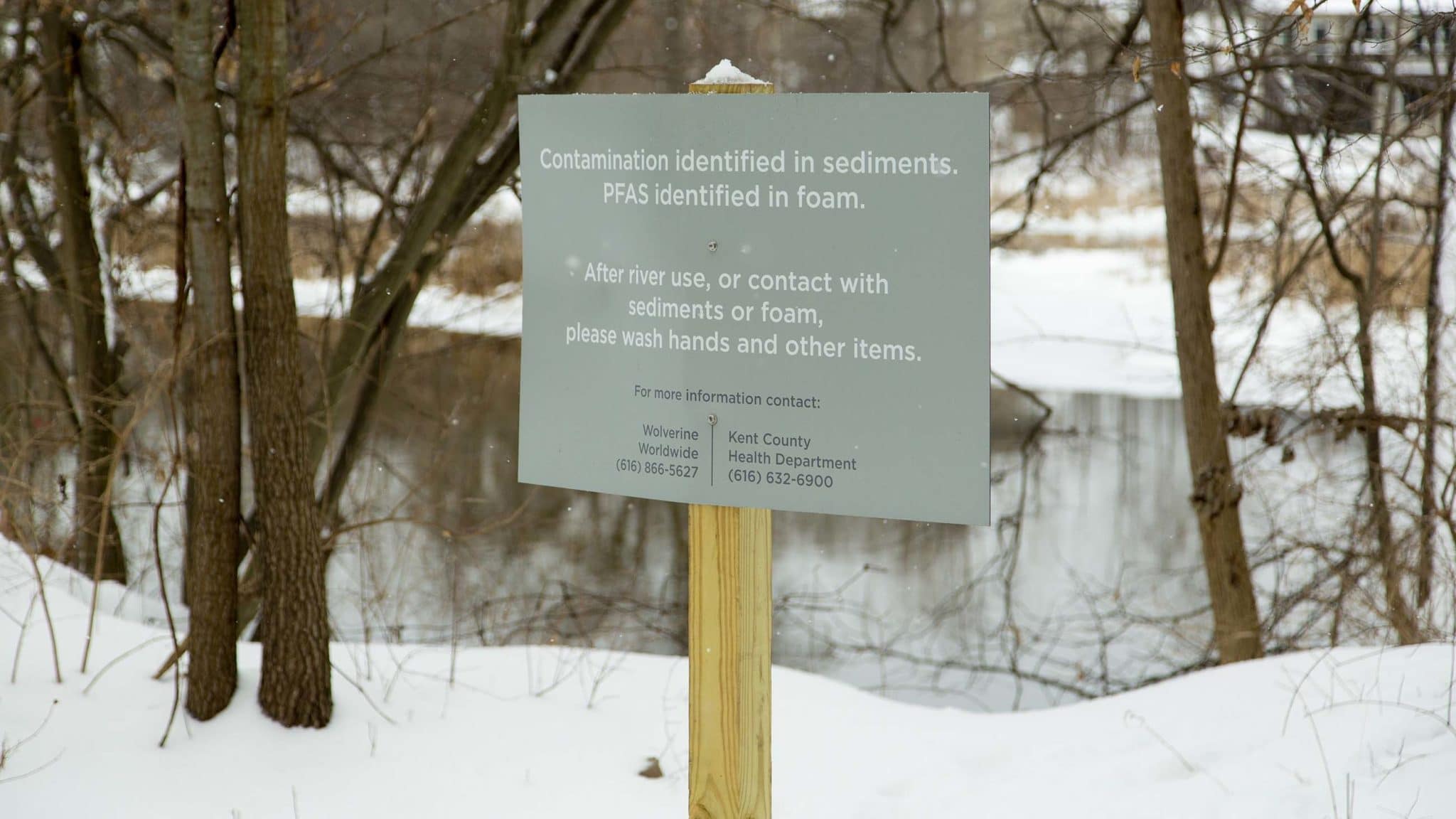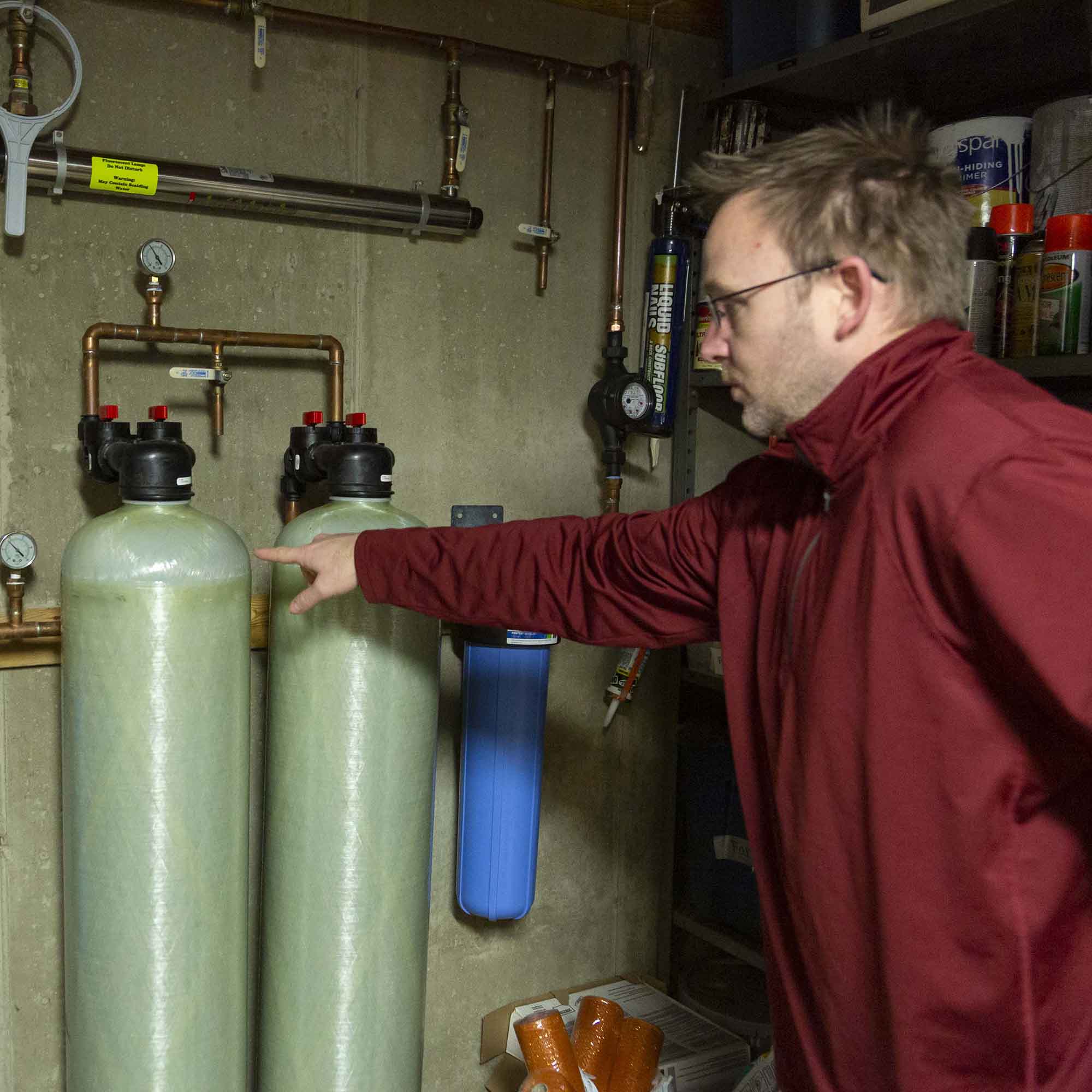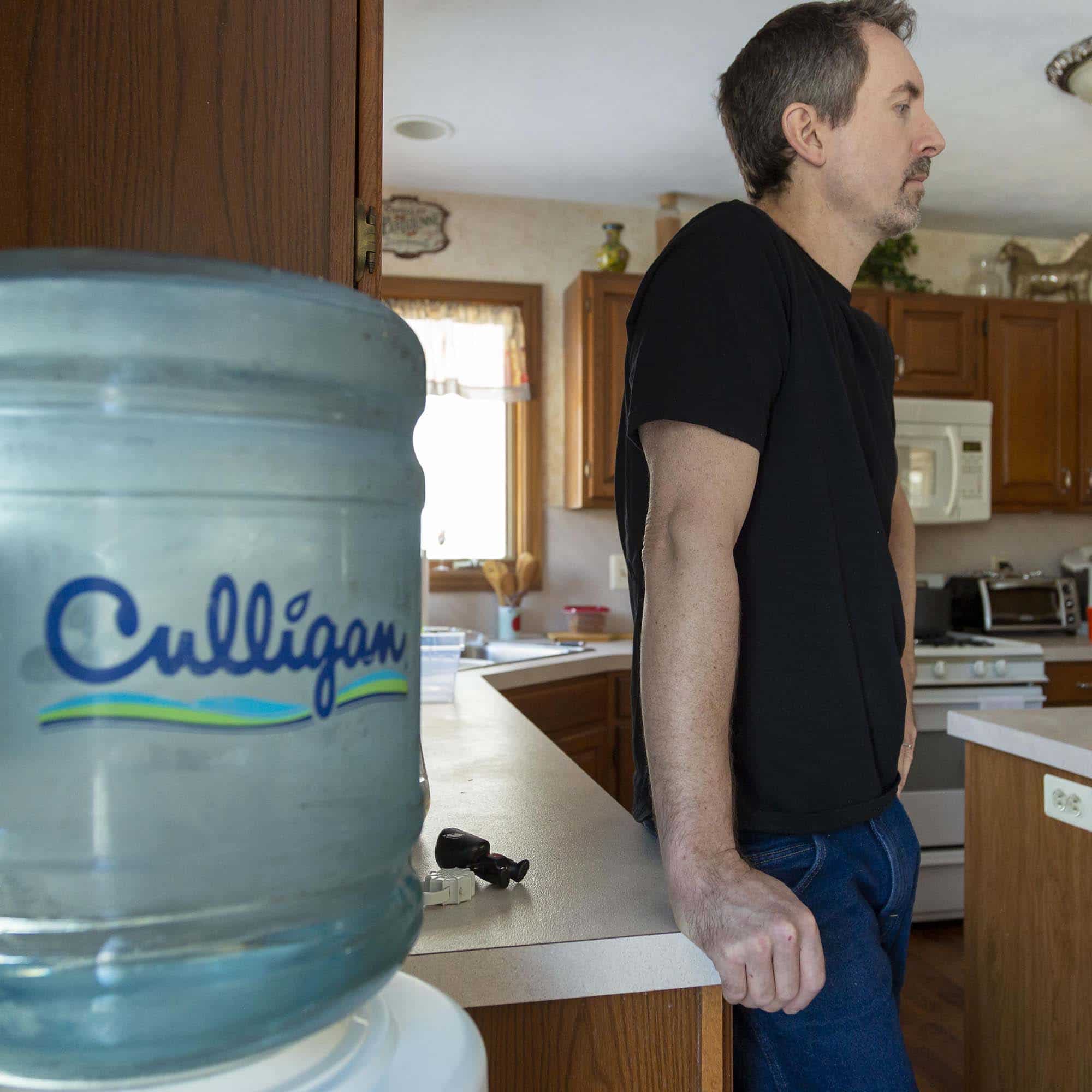Industrial Pollution Is in Your Blood. Is That a Form of Battery?
“None of us would have signed up for this,” said Sandy Wynn-Stelt, kicking off a round of gallows humor among her neighbors. “None of us would have said, ‘Hey, I’ll do the experiment.’”
It was a warm summer evening in the town of Belmont, Michigan, and Wynn-Stelt — along with neighbors Jennifer Carney and Tobyn McNaughton — was in Carney’s backyard discussing how things got upended here in 2017. That’s when they all learned that the groundwater running below their homes is contaminated with per- and polyfluoroalkyl substances — collectively called PFASs (pronounced PEE-fasses). Known as “forever chemicals” because they don’t fully degrade in the environment, these industrial compounds have been found in air, water, and soil around the globe, and in the bodies of most people. They have been associated with a laundry list of health problems, including cancer, ulcerative colitis, diabetes, and disrupted immune development. And yet, despite a recent surge in the number of studies devoted to PFASs, their health effects are not yet fully understood.
“Drink this, and then we’re going to test you!” Carney interjected, echoing her friend’s wry take.
Gaps in understanding are an urgent concern in Belmont, where locals used the groundwater for drinking, and some now have high levels of PFASs circulating in their bodies. The blood of Carney’s 9-year-old daughter, Kendall, for instance, tested five times higher than the average child’s for the two most well studied PFAS compounds. McNaughton’s 3-year-old son Jack’s blood tested 48 times higher. Wynn-Stelt’s blood PFAS levels are 584 times the national average for those two PFAS compounds. “I can’t imagine how high Joel’s levels were,” she said, referring to her deceased husband. He died of liver cancer at the age of 61, before he could be tested.
As news of the groundwater contamination spread, hundreds of Belmont residents decided to seek redress in court. Many are now represented by Varnum, a Grand Rapids-based law firm that has taken on more than 250 individual PFAS cases, including Wynn-Stelt’s, Carney’s, and McNaughton’s. In these suits, Belmont residents are going up against a pair of corporate behemoths: Wolverine Worldwide — a global footwear company whose portfolio includes Keds, Saucony, and Merrell — and 3M, the multinational conglomerate that first developed and sold PFASs. The compounds are still used in a wide variety of consumer products, including 3M’s Scotchgard fabric protectant, which Wolverine bought from 3M, starting in 1958, to waterproof Hush Puppies shoes.
Taken broadly, the Belmont suits join numerous legal claims leveled at both companies. Just last week, in a separate lawsuit filed by the State of Michigan and two townships, Wolverine agreed to a final settlement requiring the company to pay $69.5 million for public water extensions in areas affected by the PFAS contamination. And in a suit filed by Wolverine against 3M, the Minnesota company agreed to contribute $55 million to the water extension effort. Additionally, 3M is a defendant in a lawsuit filed by Michigan’s attorney general against 17 chemical companies allegedly responsible for PFAS contamination across the state.
But in their particulars, some of the lawsuits filed by Belmont residents can be seen in a different light.
Among other things, they alleged that Wolverine, headquartered five miles northeast of Belmont, recklessly disposed of its tannery waste by burying it in drums and dumping it into trenches and seepage pits at unlicensed disposal sites. Over the decades, PFASs and other chemicals leached into the groundwater, migrated through the aquifer, and turned up in the drinking water of local residents. The suits further alleged that 3M knew for decades that PFASs can persist in the environment, show toxic effects in humans and other animals, and accumulate in the blood of the general population. (According to recent data from the Environmental Protection Agency, 99 percent of Americans have PFASs in their blood.)
Legal cases involving pollution exposures and a claim of negligence are both common and, for those who bring the lawsuits, frequently disappointing. Generally speaking, to succeed with a negligence claim, the person suing must have an injury or a disease, and their attorneys must be able to prove that a particular chemical exposure caused that injury or disease. This presents a high hurdle. Because many industrial chemicals and consumer products in the United States have been introduced without initial toxicity testing, there can be a long lag between the introduction of a chemical onto the market and definitive proof of harm. PCBs, cigarettes, radium, and asbestos were all marketed and sold for decades before scientists — and later, attorneys — accumulated enough evidence to prove their dangers. Although PFASs came into widespread use in the 1950s, American regulators still consider them “emerging contaminants.” They are not currently regulated at the federal level, and the question of what constitutes a safe level of exposure remains a matter of fierce scientific and political debate.
These realties are partly behind a novel legal approach that Varnum attorneys attempted on behalf of their clients with contaminated drinking water. When Varnum filed its lawsuits against Wolverine and 3M, the complaints included at least a dozen claims, such as negligence and nuisance. In addition, some suits included a claim called “toxic battery.”
In modern law, battery is defined as intentional harmful or offensive contact with another person. If I punch or kick you, for example, that’s clearly battery — but the offensive contact need not be direct. As laid out in a classic mid-20th century legal text, it is enough for someone to simply set “a force in motion.” In other words, if I put poison in your food, or dig a pitfall along your path, that’s battery. If you spit on me, that’s battery, too.
If a company contaminates groundwater and those contaminants wind up in someone’s drinking glass, that might not sound immediately like battery, but some legal scholars say it should. In their suits, Varnum attorneys argued that Belmont residents whose domestic drinking water exceeded the Environmental Protection Agency’s PFAS health advisory level were subject to a battery — even if they did not currently have an identifiable illness.
Scholars have been writing about toxic battery at least as far back as 1993, and with hundreds of PFAS cases now making their way through courts across the country, some attorneys are testing the theory in practice. The battery claim was originally designed to protect individual autonomy, explains Lynda Collins, a law professor at the University of Ottawa. In a 2008 paper, Collins and fellow law professor Heather McLeod-Kilmurray argued the basis for extending the battery claim to industrial contamination cases: When a person’s body is “involuntarily invaded by particles of a toxic substance, her or his bodily integrity is compromised,” they wrote, “and individual autonomy is violated.” Further, they argued, environmental exposure to industrial chemicals is “involuntary experimentation on a grand scale,” and there are already legal precedents for treating this as battery.
To supporters, it’s a bold new avenue for argument that could ultimately prove successful against industries that have historically enjoyed the latitude to expose first and answer questions later. But skeptics argue that toxic battery claims face high hurdles. And at a recent federal hearing, representatives from major American companies that use and produce PFASs — 3M, DuPont, and Chemours — maintained that they have done nothing wrong. In an email message to Undark, a 3M spokesperson wrote that the company “acted responsibly in connection with products containing PFAS and will vigorously defend its environmental stewardship.”
Indeed, the road ahead for plaintiffs pursuing toxic battery claims is not straightforward. In December, Judge George Quist decided to dismiss Varnum’s battery claims in two test cases, and that decision will likely be extended to the firm’s other lawsuits. And last week, Tobyn McNaughton and her husband, Seth, reached a confidential settlement with Wolverine and 3M, with Varnum attorney Aaron Phelps saying his firm was looking forward “to the prompt and fair resolution of the remaining claims by other affected residents.”
But with PFAS litigation on the rise, the toxic battery claim is certain to be further tested and argued in courtrooms nationwide, and the Belmont cases offer a glimpse of both the promise and challenges of a battery claim in answering a foundational question of modern life: Should industrial compounds be allowed to penetrate the bodies of ordinary citizens when the safety of those compounds has not been established and consent has not been granted?
For many Belmont residents, that question can seem absurd on its face — and the answer a hard no: “Why don’t I just drink something, or breathe something, or eat something,” Wynn-Stelt quipped, continuing the withering and sardonic repartee among her Belmont neighbors, “and then 20 years later, tell me what it was?”

Experts estimate that the typical American has elevated levels of about 75 industrial contaminants stored or circulating through the body. What this means for human health, though, is not well understood — and it seems easy to understand why. In his 2017 book “Tragic Failures: How and Why We Are Harmed by Toxic Chemicals,” Carl Cranor, a professor of philosophy at the University of California, Riverside, noted that independent researchers begin with “considerable ignorance” of industrial compounds. Studies generally occur only after a substance has been released onto the market, if and when scientists suspect it may be harmful.
To establish causation, several kinds of studies need to be conducted, Cranor explained. These include experiments on non-human animals such as mice. Studies of human populations are important, too, but they can take years to reveal the full extent of a contaminant’s risk. A young child — McNaughton’s 3-year-old son Jack, for example, or Carney’s 9-year-old daughter Kendall — consuming contaminated drinking water today might not develop a related cancer for several decades. The battery claim, proponents argue, could deter companies from putting these kinds of substances onto the market without safety testing.
In conversation, Jennifer Carney frequently references the limitations of PFAS science, particularly its inability to explain the symptoms of her 16-year-old son, Dylan. He struggles with gastrointestinal issues, which have caused him to miss a lot of school. His grades have plummeted, and now he takes courses online. PFAS exposure is linked to ulcerative colitis — an inflammatory bowel disease that can cause diarrhea and abdominal pain — but a gastroenterologist has said that the boy’s symptoms don’t add up to a diagnosis. Meanwhile, Kendall, who was a baby when her family bought their Belmont house in 2011, has higher PFAS levels than her brother, but no symptoms.
Carney wonders about her children’s fates as they get older: Will they develop cancer or struggle to have children of their own? She knows that science can’t answer that definitively — at least not yet. “You just sit there and look at your kids like, what the hell is going to happen down the road?” she said.
As it stands, very little was publicly known about the possible health effects of PFAS exposure before May 16, 2000, when 3M announced a phaseout of its two most well-studied compounds in the PFAS family, perfluorooctane sulfonate (PFOS) and perfluorooctanoic acid (PFOA). In a press release, the company explained that the decision was based on “principles of responsible environmental management.” An internal EPA memo issued the same day was less sanguine. Prior to announcing its phaseout, 3M had turned over hundreds of previously withheld documents to the agency. In its memo, the EPA described some of those documents and observed that PFOS “appears to combine persistence, bioaccumulation, and toxicity properties to an extraordinary degree.”
Less than a year later, the agency received another round of information about PFASs. It arrived from a Cincinnati-based attorney named Rob Bilott, who famously represented a cattle farmer in a lawsuit against DuPont. As part of any litigation, the process of “discovery” requires both plaintiffs and defendants to turn over relevant documents to the other side. In Bilott’s case, DuPont handed over more than 100,000 pages of internal documents, which included details on PFOA and its use in the manufacture of DuPont’s wildly popular chemical coating, Teflon. For years, a DuPont plant in Parkersburg, West Virginia, had been emitting tons of a salt form of PFOA into the air and local water supply. Further, the documents indicated that the company knew the compound accumulates in the human body and could have toxic effects. In the ensuing years, the EPA would fine DuPont and 3M for violating rules of toxic waste. Under agency pressure, eight major companies agreed in 2006 to a phaseout of PFOA.
Since 2000, research into PFASs has exploded. A massive study — conducted as part of the settlement in Bilott’s second lawsuit against DuPont — tested nearly 70,000 residents whose water had been contaminated with PFOA coming from the Parkersburg plant. The study’s independent researchers found a probable link between exposure and six conditions: high cholesterol, ulcerative colitis, thyroid disease, testicular and kidney cancers, and pregnancy-induced high blood pressure. Other studies have found an association between PFAS exposure and type 2 diabetes, lowered testicular volume and penis length, and immune system disruption, among other things.
In 2016, the EPA issued its current health advisory, suggesting to state health officials that drinking water should not exceed 70 parts per trillion, or ppt, of PFOA and PFOS combined. In 2018, the Agency for Toxic Substances and Disease Registry, a branch of the Centers for Disease Control and Prevention, issued a lengthy draft report recommending a daily “minimal risk” level for certain PFASs. When the agency converted those levels to drinking water limits, it came up with 21 ppt for PFOA and 14 ppt for PFOS in children. (Documents obtained by the nonprofit Union of Concerned Scientists through a Freedom of Information Act request revealed that the Trump administration attempted to suppress the report, which it deemed a “public relations nightmare.”)



Some scientists say that even the CDC’s levels are not protective enough. Philippe Grandjean, a professor at Harvard’s T.H. Chan School of Public Health, published a 2012 paper describing his ambitious study assessing children’s antibody responses to immunizations. He found that a doubling in exposure to PFOS and PFOA was associated with an overall decrease by up to 50 percent in the vaccine antibody concentration. This led his team to recommend a drinking water level of just 1 ppt or less to protect children’s immune systems. By this measure, Jack McNaughton was exposed to more than 1,000 times the recommended level of PFAS chemicals, as indicated by tests of his family’s well water.
At 1 ppt, it’s not just Belmont children who face an increased risk. The nonprofit Environmental Working Group, in collaboration with Northeastern University, maintains an interactive map of PFAS contamination in the United States. Clicking on one of the blue dots reveals, for example, that at the time of testing, children served by the Sacramento Suburban Water District received water with a PFAS concentration 12 times greater than the Harvard team’s recommendation. Children served by the Bethany, Oklahoma, water district received water 40 times greater. And children served by the Cleveland Heights City Public Water System received water 400 times greater.
Since that 2012 paper, additional studies have found an association between PFAS exposure and immunotoxicity, particularly in children. A 2018 report issued by the Michigan PFAS Science Advisory Panel predicted that “disruption of immune development is likely to have broader impacts” than the antibody changes directly observed in these studies. Immune system dysfunction plays a role in many diseases, including allergies, autoimmune disorders, and some cancers. In an email, Grandjean noted that immunotoxicity could contribute to the increased risk of cancer associated with high PFAS exposure, though the biological mechanism has not been identified.
For now, Belmont residents are left to grapple with uncertainty — and a profound sense of violation. “We re-hung a punching bag in the downstairs,” Carney said, so Dylan can use it to let out his frustration.
For all the specificity of the EPA’s and CDC’s recommendations — and despite the mounting evidence of potential harms being uncovered by scientists — existing regulatory standards, along with the risk assessments that underpin them, are not always useful in court. For example, in the case Rhodes v. E.I. DuPont de Nemours & Co., a group of people receiving contaminated municipal water had their attempt at a class action denied. Among other things, the judge noted that the plaintiffs’ risk assessment did not demonstrate the level at which an exposure causes a significantly increased risk of disease — something that scientists are still trying to work out. Absent such information, the judge wrote, “I find that a risk assessment is of limited utility.”
The chemical industry and some of its customers often make use of this knowledge gap in downplaying risks to human health. The FluoroCouncil, a global trade group representing the fluorochemicals industry, maintains, for example, that the thousands of replacement PFASs now in use are safer and break down faster than PFOS and PFOA. (Independent researchers are not so sure. A recent review concluded that the newer iterations “may pose broader risks” to human and ecosystem health than the PFASs they replaced.) And when the Wolverine contamination came to light, the company hired a toxicologist, Janet Anderson, who wrote a blog post with nine “facts” about PFASs. Fact number one: “Human health effects from exposure to PFAS in the environment are unknown. There is no human study that has been conducted that proves exposure of an individual to any PFAS, including PFOA or PFOS, causes any illness.”
While the statement is technically true, such a study would require directly and intentionally exposing humans to PFASs, says Jamie DeWitt, a toxicologist at East Carolina University. Further, because many diseases associated with PFAS exposure are latent, researchers would have to track participants for decades to fully understand the health effects. Such a research effort “would be challenging,” DeWitt said, “and really not ethical.”
But is the status quo ethical? In their toxic battery paper, Collins and McLeod-Kilmurray argue that, right now, communities like Belmont are being used to unwittingly test the safety of industrial chemicals. They believe this constitutes a battery, and they point to a precedent-setting case to explain why: For two years in the early 1950s, every pregnant woman at the University of Chicago’s Lying-In Hospital became part of a medical experiment. Half received diethylstilbestrol (DES), a synthetic estrogen thought to prevent miscarriages. The other half received a placebo. The women were not told about the experiment, nor were they told what drug they were taking. Eventually, the study would show that miscarriages were more common among those who received the drug. Among children brought to term, exposure to DES in the womb was eventually linked to a range of conditions later in life, including cancer, infertility, and genital abnormalities.
Patsy Takemoto Mink, who would later become a member of the House of Representatives, was one of the mothers placed in the experiment. In 1977, she and two other exposed mothers filed a lawsuit. Among other things, the mothers claimed that the University of Chicago had committed a series of batteries by performing a medical experiment on them without their knowledge. The court agreed. “It was all very traumatic,” Mink’s daughter, Gwendolyn, wrote in an email, “the news itself, the violation we both felt, my mother’s horror that she was unknowingly the vehicle through which I was injured, and my trepidation about my medical future.”
Two years after Mink v. University of Chicago was filed, a congressional commission released the Belmont Report, an influential document outlining ethical principles intended to guide research on human subjects. Among the basic tenets: Individuals must consent to participate in research, and the consent must be based on participants’ informed understanding of the risks to which they will be exposed.
On July 24, 2019, Wynn-Stelt flew to Washington, D.C., and testified before the House Committee on Oversight and Reform. It was the committee’s second of four hearings on PFAS chemicals, and Wynn-Stelt was part of a panel of three citizens whose communities have been affected by PFAS contamination.
The citizen panelists faced a mix of sympathetic and skeptical inquiries. Representative Rashida Tlaib, a Democrat from Michigan, held up a picture of Jack McNaughton and invited Wynn-Stelt to share her concerns about his health. Representative Bob Gibbs, a Republican from Ohio, pointed out that “significant research has only really been done on three of the 5,000” PFAS chemicals. While that might have seemed a call for caution before exposing consumers to the other 4,997 unstudied compounds, the implications of Gibbs’ rejoinder were spelled out later, at the fourth PFAS committee meeting, when Representative James Comer, a Republican from Kentucky, noted that “thorough research has only been done on a small number” of PFAS compounds. “So, we should be careful about taking any sweeping actions that could have the unintended consequence of negatively impacting a broad segment of the economy,” Comer stated.
This wasn’t Wynn-Stelt’s first time speaking with legislators. Over time, she has become one of several faces of PFAS contamination across the country. The 60-year-old clinical psychologist has given interviews to CNN and CNBC, among other media outlets. And she is part of state and local community groups working to address PFAS contamination. “I’m naturally a big mouth,” she said with a characteristic mix of humor and self-deprecation. “I’m not shy.”
The contamination has taken a toll on younger families in her neighborhood, Wynn-Stelt says — families with young kids and working parents whose time and resources are already stretched thin. With no children of her own and her husband gone, she says she’s motivated to do what she can to contribute to Belmont’s fight. The problem, as she sees it, is also clear-cut: “I don’t know,” she asked rhetorically, “should people have clean water?”
Though Wynn-Stelt has taken on a public role, the litigation has impacted some of her most private relationships. In the same way DuPont was required to hand over documents for discovery during its litigation over Parkersburg, Belmont plaintiffs must share any materials that mention water or Wolverine. This includes texts, calendars, emails, and journal entries. Plaintiffs must also compile a list of anyone they’ve spoken to on these topics, not just legislators and media, but hairdressers, bosses, friends, and spouses.
The evening we met at Carney’s home, Wynn-Stelt, Carney, and McNaughton spoke at length about the psychological toll of the discovery process. “Imagine that feeling of everything you do, everything you text — all your innermost thoughts — have to be discussed in front of 3M and Wolverine,” said Wynn-Stelt.
“Don’t go up against a corporation, you’ll be sorry,” said McNaughton, acerbically. Then she paused and registered her own conviction: “I’m not sorry.”



“In a crowded world,” one classic legal tome on torts declares, “a certain amount of personal contact is inevitable, and must be accepted.” This means that “consent is assumed to all those ordinary contacts which are customary and reasonably necessary to the common intercourse of life.” In other words, if you’re sitting on the subway, and I brush against your leg while searching for a spot, that is not a battery. Likewise, if you tap me on the shoulder to get my attention in the checkout line, you have not committed a legally actionable offense.
Jeffrey Dintzer, a corporate attorney involved in PFAS cases across the country, makes a similar point. “You’re not going to run into court because I put my finger on your shoulder for a second,” he said in a telephone interview. “That’s what we have to be cognizant of here. Look, we all are exposed to lots of different chemicals every single day. That’s part of the world we live in.”
Not only that, Dintzer added, we embrace the benefits that these compounds bring to consumer products. “We all use Scotchgard. We all have weatherproof jackets,” he said. “We all like Teflon pans because your food didn’t stick and it was easier to clean up the pan when we’re done with it.”
A 2009 article by Steven N. Geise, a corporate defense attorney whose list of clients includes the R.J. Reynolds Tobacco Company, and Hollis R. Peterson, now of the San Diego law firm Paul, Plevin, Sullivan & Connaughton, takes aim at what they described as “a new wave” of lawsuits claiming that chemicals in a person’s bloodstream afford grounds for legal action. “Influenced by modern crime dramas and sensationalized media accounts,” they wrote, “the public is often led to believe that even minute levels of toxins are harmful to their health.”
Geise and Peterson point out that blood tests often come with a host of unknowns. The presence of a contaminant in a person’s tissues generally can’t illuminate how the chemical got there, for example, nor how long it has been in the body, nor whether it poses a health risk. The courts, write the authors, will increasingly be asked to decide whether companies are legally responsible for “the mere presence of chemicals” in an individual’s body when that individual has no injury or disease and the causal link between exposure and disease has not been proven. “Common sense and legal precedent tell us the answer should be no,” they stated.
Their stance has some practical merit. According to the CDC, for example, blood testing for PFASs is of little prognostic value. It can’t tell you that this chemical in your blood is the cause of this ailment you’re experiencing — much less an ailment or disease you might develop decades from now. But that might one day change. Across the country, communities dealing with PFAS contamination have appealed to state and federal legislators for help. “You’re never going to get a community to [voluntarily consume PFAS],” Carney noted. To better understand the health effects of PFAS exposure, “you might as well find somebody already contaminated and test them.”
The 2018 National Defense Authorization Act allocated $20 million to lay the groundwork for just such a multi-site health study. As a first step, the CDC is currently conducting what is referred to as an “exposure assessment” in communities near current or former military bases where PFASs have been detected in the drinking water as a result of the military’s use of PFAS-laden firefighting foam. In Michigan, the Kent County Health Department and the Michigan Department of Health and Human Services were already running their own exposure assessment when the region was accepted into the federal study. As part of the assessment, northern Kent County residents, including residents in Belmont, volunteered to have their blood drawn and their tap water collected. Ultimately, officials hope to use the data to better understand how exposure to contaminated tap water influences an individual’s blood PFAS levels.
Activists, public health advocates, and some legal scholars say that these studies should not be used as an excuse to delay regulation. Cranor, for example, says the length and complexity of scientific studies give chemical manufacturers a place to hide. “We don’t know causation!” he said, imagining a chemical company’s position. “We don’t know enough yet!”
If you’re a truck driver transporting toxic waste, and your vehicle gets hit, causing the waste to spill into the river and contaminate a community’s drinking water — that, alone, is not a battery. Battery is one of several so-called “intentional” legal claims in tort law. The concept of “intent” is one of the most basic organizing principles of the law, and to win an intentional case, one must have evidence that the defendant intended the result — though that doesn’t necessarily mean the defendant desired the result. Intent can extend to consequences that a defendant believes are substantially certain to occur.

Attorney Aaron Phelps represents more than 400 area residents who consumed PFASs and now worry that their health has been impacted — or one day will be. “It doesn’t seem right,” Phelps said, to tell those people, “tough luck.”
“We don’t think it’s hard to establish intent when people are emitting contaminants in a populated area,” the University of Ottawa’s Collins said. Once contaminants are released into the air, water, and soil, contact with human beings is inevitable, she says. A small body of American case law supports toxic battery as a route toward redress. In their paper, Collins and McLeod-Kilmurray cited a number of successful toxic battery cases, including one decided in 1990 called Werlein v. United States. In that case, a court ruled in favor of residents who lived near an army ammunition plant that contaminated the local water supply by discharging toxic chemicals into sandy ground directly above a regional aquifer. Among other things, the court stated that there was sufficient evidence that the defendant knew its conduct was “substantially certain to cause an offensive or harmful contact.”
Collins acknowledges that society has benefited from industrialization and therefore, everybody’s going to be exposed to some amount of industrial chemicals. “But where do you draw the line?” she asked. In order to minimize both health risks and litigation, Collins suggests that companies should seek to establish a new chemical’s safety before it’s put on the market, thereby eliminating the harmful or offensive nature of the contact.
Legal texts aside — and despite some episodic use in courtrooms — toxic battery, as applied to corporate polluters, remains an uncommon legal strategy. Jean Eggen, a professor emerita at Widener University Delaware Law School, suggests that may in part be due to the fact that intent is a squishy concept. “There’s not really a bright line there as to what it means to be ‘substantially certain to occur,’” she said. “It’s probably going to depend upon the facts of the given case.”
Last August, Varnum attorneys said they are not pushing for sweeping change. Instead, their cases rest on the particulars. Aaron Phelps, for example, emphasized that compounds like PFOA and PFOS linger in the body a long time. That makes them different from contaminants with “no permanence to your body, no likelihood of causing any particular injury.” In the latter case, Phelps explained, “the law is very reluctant to give some kind of remedy for that because it would be so sweeping and there would be so many people affected. And how do you even calculate the damage?”
And as for intent, there’s the matter of discovery documents — not only from Bilott’s lawsuits against DuPont, but also from the State of Minnesota’s more recent lawsuit against 3M. Together, these suits have uncovered documents indicating 3M knew in the 1970s that PFAS accumulates in the body and had been found in the blood of the general population.
“That gets directly at what we’re talking about with battery and the dignity of the human body,” said Varnum attorney Paul Albarran.
Varnum attorneys suggested that the contamination of residential wells is, in essence, a poisoning. If “somebody comes along and injects poison into your body, we all recognize that’s offensive at a minimum, if not harmful,” said Phelps. Those with a corresponding “health outcome, an injury,” can bring a negligence claim, he explained. But what about all the others who consumed PFASs and now worry that their health has been impacted, or one day will be?
That’s the key legal question, said Phelps. “It doesn’t seem right,” he added, to tell those people, “tough luck.”
On December 6, 2019, Wynn-Stelt, McNaughton, Carney, other Belmont residents, and no fewer than 10 attorneys filed into a Grand Rapids courtroom for a hearing on the PFAS test cases. Among other things, 3M and Wolverine had filed motions seeking dismissal of Varnum’s battery claims. The companies maintained that there was no factual support to justify the claims and that the judge should not allow them to proceed to trial.
In their written materials, both corporations took particular aim at the idea of intent. 3M wrote that from 1958 to 1970 — the time of Wolverine’s dumping — “Wolverine controlled all aspects of its waste disposal.” Further, 3M attorneys wrote, PFASs were not regulated in Michigan at the time of the dumping, and it was not until 20 years later that houses were built nearby. For its part, Wolverine pointed to documents from the State of Michigan endorsing its use of the landfill. In court, Wolverine attorney Janet Ramsey pointed to what she characterized as a lack of evidence of intent: “There is still no evidence that Wolverine knew that PFAS from its waste was substantially certain to harmfully or offensively touch any individual.”

Phelps countered that Wolverine intentionally forced its waste into the groundwater by drilling boreholes, and that the company misled regulators about the contents of the waste. He also disagreed with the companies’ narrow focus on the time of the dumping. “They want to also draw a magic line at 1970 as if nothing that happened after that could possibly matter because they stopped dumping.”
Ultimately, the judge sided with the companies. “At most the evidence suggests that 3M may have known about the harmful effects of PFAS in the 1970s and thereafter,” wrote Judge George Quist in his opinion. “[Wolverine] had stopped dumping at the site at issue by that time.”
In a phone interview, Jennifer Carney expressed a mixture of frustration and disappointment with the decision. “I think the judge was like, ‘Uhhh, that’s a lot of pressure,’” she said. “‘If I say yes and accept this, it’s going to open the floodgate and these polluters are going to have to pay up for all these lawsuits.’
“That really does suck,” she added. “I watch people make comments online about ‘I really wish I could file a claim,’ and their cases are so much weaker than what ours are. [We are] trying to push through with the strongest cases — and it’s hard. I’m like, nobody else is even going to make it. We’re barely pushing through and working our butts off,” said Carney. “These chemical companies and polluters are just going to be able to get away with it.”
Perhaps. But it won’t be the last battery claim related to PFASs. In 2018, Rob Bilott and two other attorneys filed a class action on behalf of the 99 percent of Americans with PFASs in their blood. The suit, which includes a battery claim, is not seeking monetary compensation, but rather, another independent science panel to confirm the health effects of exposure. Among the allegations: “Defendants have used and/or continue to use Plaintiff and the other class members as human guinea pigs in a decades-long experiment.”
Wynn-Stelt said her husband Joel’s health problems started just over four years ago. The first symptom was excessive bowl movements. At Christmastime in 2015, her husband looked jaundiced. Then, on a February evening, he began to vomit. One thing led to another, and soon he had a cancer diagnosis.

Did PFASs kill Wynn-Stelt’s husband? “I’m not a scientist,” she carefully stated. “I can’t make that determination.” But, she allowed, the years of exposure to contaminated drinking water “probably didn’t help anything.”
The following three weeks were the stuff of nightmares. Joel’s chest filled with fluid, requiring return trips to the hospital. As his organ systems started shutting down, he could no longer make it to the bathroom on time, so Wynn-Stelt carried him. When Joel lost the ability to read, she got into bed and read to him. “I knew that was the beginning of the end,” she said.
Joel died 26 days after the diagnosis. Did the PFASs kill him? “I’m not a scientist,” Wynn-Stelt carefully stated. “I can’t make that determination.” But, she allowed, the years of exposure to contaminated drinking water “probably didn’t help anything.”
Now she lies awake at night ruminating over unanswerable questions. “Cancer is so common now. Is it common because we have so many more toxic chemicals that we’re exposed to?” she wondered aloud. “Is it common because we’re ingesting this stuff at incredible rates?” Maybe someday, science will have the answers. After all, that’s why she and her neighbors — and people in affected communities across the country — are contributing their blood to the CDC’s study.
When asked if she feels like a guinea pig, Wynn-Stelt said, not quite. In a scientific experiment, someone measures doses and carefully monitors study participants for any effects. That’s not what happened to Joel, to Jack McNaughton, or to the 99 percent of Americans with forever chemicals circulating in their blood. And it’s not what happened to her.
“I feel,” she said, “like somebody’s trash receptacle.”
Sara Talpos is a senior editor at Undark whose work has also been published in Science, Mosaic, and the Kenyon Review’s special issue on science writing. Sara has an MFA in creative writing (poetry) and is interested in the connections between science and literature.
Reporting for this article was supported in part by the Institute for Journalism and Natural Resources.












Comments are automatically closed one year after article publication. Archived comments are below.
I agree with you